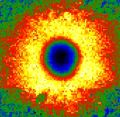Speaker
Description
Stainless steel is widely used in our daily life due to a unique combination of high corrosion resistance and excellent mechanical properties. Despite its importance, there is a lack of surface science characterization of stainless steels due to the absence of suitable single crystals. Here we use steel single crystals with a composition of 70% Fe, 15% Ni and 15% Cr [1] to demonstrate that this material can be characterized by the tools of surface science, down to the atomic level precision. The selected alloy transforms from the austenitic to martensitic phase upon cooling to ~200 K and shows a strong hysteresis during annealing. The high-temperature austenitic phase is valued for its high corrosion resistance and nonmagnetic character, while the low-temperature magnetic martensitic phase is mostly used for applications requiring high hardness. Here combined Scanning tunnelling microscopy/atomic force microscopy is used to image the surface of this alloy at the atomic scale. X-ray photoelectron microscopy and low energy ion scattering are used to characterize the atomic composition of the surface and the near-surface regions.

